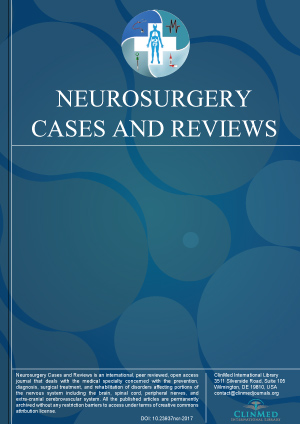Open Access DOI:10.23937/2643-4474/1710099
Surgical Implications of Internal Jugular Stenosis in a Patient Undergoing Resection of a Craniocervical Junction Meningioma
Catherine Zhang, Lauren Harris, Hamza Itum, Sanjiv Chawda, Julian Coker, Jonathan Pollock, Ahmed Sadek and Shoakazemi
Article Type: Case Report | First Published: March 05, 2022
Internal jugular vein (IJV) stenosis is being increasingly associated with certain neurological conditions, including benign intracranial hypertension, cerebrospinal fluid (CSF) disorders, multiple sclerosis and Alzheimer’s disease. The role of surgery in IJV stenosis have typically been to manage the associated CSF disorders, or with IJV stents. We describe a case of a patient incidentally found to have bilateral possible IJV stenosis with dilated paraspinal collateral venous channels during ...
Open Access DOI:10.23937/2643-4474/1710102
Cerebral Metastasis Secondary to Distant Malignant Cutaneous Squamous Cell Carcinoma in an Immunosuppressed Patient
Christopher Alan Brooks, Jessica Wang, Ashraf Dower, Alar Enno, Andrew Bonura and Joanna Lee
Article Type: Case Report | First Published: March 25, 2022
Squamous cell carcinoma of cutaneous origin is an insidiously developing cancer, and seldom metastasises. Patient and lesion characteristics that predispose to more aggressive biological behaviours include immune incompetence, recurrence following excision and those demonstrating invasion of local lymphovascular and neural structures. An elderly man with a history of Crohn’s disease requiring long-term immunosuppression, and cutaneous squamous cell carcinoma of the chest wall with locoregional...
Open Access DOI:10.23937/2643-4474/1710101
Triple-Region Spinal Stenosis - A Diagnostic and Operative Dilemma!
Ketan S Khurjekar, Himanshu Gurunath Kulkarni, Shailesh Hadgaonkar, Ajay Kothari, Parag K Sancheti and Ashok Shyam
Article Type: Case Report | First Published: March 25, 2022
The term ‘tandem spinal stenosis’ (TSS) is usually used to describe a double stenotic lesion in the cervical and lumbar spine, which are the most mobile segments of spine. There have also been a few reports describing the clinical course of tandem thoracic and lumbar spinal stenosis. Triple-region spinal stenosis (TRSS), or concurrent stenosis in the cervical, thoracic, and lumbar spine is the least documented variety of tandem spinal stenosis in literature. Combination of three co-existing ...
Open Access DOI:10.23937/2643-4474/1710098
Ruptured Posterior Fossa Teratoma Mimicking Intracranial Haemorrhage: A Case Report
Maia Osborne-Grinter, MBChB, Julie Woodfield, PhD, Ana M Casado Lopez, LMS, Anna Solth, FCSEd (SN) and Mark A Hughes, PhD
Article Type: Case Report | First Published: February 12, 2022
Posterior fossa mature teratomas are rare congenital lesions that contain differentiated tissue from all three germ cell layers. The imaging characteristics can be highly variable, reflecting the variety of potential tissue types. A 22-year-old presented with headache, papilloedema, and diplopia. CT head showed a hyperdense lesion in the posterior fossa, initially suspicious of haemorrhage, with acute hydrocephalus. Digital subtraction angiogram was normal. MRI was suggestive of a melanin contai...
Open Access DOI:10.23937/2643-4474/1710097
Betablocker Use in Cerebral Proliferative Angiopathy: Case Report
Glaucia Suzanna Jong A Liem, Fernando Mendes Paschoal Junior, Feres Eduardo Aparecido Chaddad Neto, Eberval Gadelha Figueiredo, Manoel Jacobsen Teixeira, Edson Bor-Seng-Shu and Eric Homero Albuquerque Paschoal
Article Type: Case Report | First Published: February 10, 2022
We describe a case of cerebral proliferative angiopathy in a patient with frequent episodes of disabling headaches. The clinical details, radiographic and angiogram findings and medical management are reviewed. This is the first described cerebral proliferative angiopathy case in which we noticed shrinkage of a vascular lesion with the use of a betablocker. A 29-year-old young man attended the neurosurgery outpatient clinic with a chief complaint of headache, mild cognitive impairment, and inter...
Open Access DOI:10.23937/2643-4474/1710096
Treatment of Familial Hypercholesterolemia with Intracranial Xanthoma: Case Report
XiaoBo Kou, MS, LunXin Liu, MD and LiangXue Zhou, MD
Article Type: Case Report | First Published: February 05, 2022
Intracranial xanthoma is a rare benign intracranial tumor. It often occurs in patients with hyperlipidemia. Intracranial xanthomas grow slowly, and clinical symptoms only appear when the mass compresses the surrounding tissues, so early diagnosis of the disease is difficult. A 25-year-old female complained of right-sided facial paralysis and hearing loss for 4 years, and an intracranial mass was found for 1 week. The patient had a history of FH and excision of the left elbow mass; positive sign:...
Open Access DOI:10.23937/2643-4474/1710095
Malignant Transformation of a Peripheral Nerve Sheath Tumour in Neurofibromatosis Type 2
Ali A, Parry A, Halliday D, Pretorius PM and Halliday J
Article Type: Case Report | First Published: January 22, 2022
To report a rare case of malignant transformation of a peripheral nerve sheath tumour (MPNST) with associated metastasis in a patient with Neurofibromatosis 2 (NF2). NF2 is a hereditary disorder which presents with both central and peripheral nervous system tumours; caused by defects in the long arm of chromosome 22. The prevalence of NF2 is 1 in 50,000. NF2 is not a recognised risk factor for malignant transformation of schwannomas and this in this group is rarely seen, despite their high burde...
Open Access DOI:10.23937/2643-4474/1710094
Simultaneous Discrete Intradiploic and Intracerebral Atypical Epidermoid Cysts: Possible Embryological Theories
Ya Lyn Samantha Ang, MBBS, FRCSEd, FAMS, Jiani Sherry Liu, MBBS, Chi Long Ho, MD, MMed, MRCS, FRCR, FAMS, Cristine Szu Lyn Ding, MBBch Bao, FRCPath and Jai Prashanth Rao, MBBS, MMed, FRCSEd
Article Type: Case Report | First Published: January 14, 2022
Epidermoid cysts are benign indolent lesions that account for around 1% of all primary brain tumours. Embryologically, they are thought to arise from entrapped ectodermal elements during neural tube closure. They often display classic magnetic resonance imaging (MRI) characteristics compared to atypical ‘white epidermoids’ which display reversed MRI signal intensities. In this article, we describe a 55-year-old lady who presented with progressively worsening headaches and was subsequently fo...

